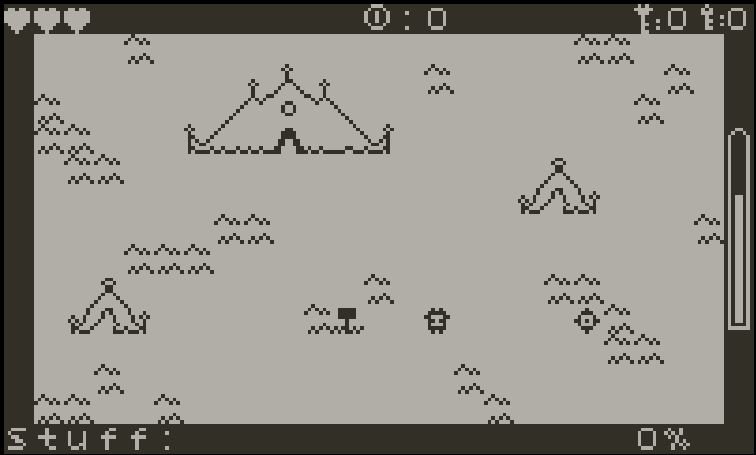Aurora: Oasis Adventure
Aurora: Oasis Adventure is a Pulp-made Zelda-like from a first-time game dev, and since it’s on the Playdate it will be inevitably compared to Resonant Tale, another Pulp-made Zelda-like on the Playdate. Whereas Resonant Tale was very inspired by Link’s Awakening, however, Aurora: Oasis Adventure feels a lot more like the original NES The Legend of Zelda. The world is a bit more sparse and open, and the focus on swordplay (after, of course, you find a sword – another Zelda staple!) is a lot more important. Resonant Tale barely even has combat, and Orange Thief’s later game Lolife did sword action in a more Ys manner. A:OA nails the feel of the old Zelda sword in a way that most games, for one reason or another, can’t manage.
It’s also time for me to bring up Tunic again, which is basically the first Zelda game with an additional 30 years in the oven. You’re never quite sure where to go, or what to do, and there is no hand holding. A:OA is like that. It’s not a huge world, and the later locations are blocked off by specific items, Metroidvania-style. So there’s a lot of wandering around, talking to people for hints, and trying to figure out where you should go next.
For a first game, it’s very impressive. There are four full dungeons, a half-dozen or so items to discover to unlock additional places in the world, and a handful of different enemy types (they all just take one hit with the sword, though, and the strategies for non-boss fights are basically all the same – just don’t get swarmed). The map is big enough to feel worthy of exploration but small enough that you don’t get lost. There is one mechanic that was an interesting choice, though, and I’m not sure if it 100% works for me? It’s the crank use.
So you wake up on the beach (as you do), and you’re like a wind-up… mouse? Creature? You’re a little wind-up guy. You have to physically crank the crank to fill your battery gauge on the side of the screen. You eventually get items that increase the capacity or increase the recharge rate, meaning less cranks to refill, but at the start, you’ll be cranking on nearly every single screen. When you run out of battery, you can’t move. You can still swing your sword, though. So it can kill you if you run out of juice on a spiked floor or during a boss fight, but the rest of the time it feels a bit gimmicky. And this is coming from someone that played a ton of Chibi-Robo, another game with a constantly draining battery limiting your range.
In Chibi-Robo, though, it used the mechanic to keep you from going too far, too fast, and the battery expansions would open entire new rooms to explore. In this one, it feels more like a chore to keep your little guy moving. It’s like sprinting in Grand Theft Auto – I should be able to do it as much as I want when I’m just running around exploring the world or doing minigames, but feel free to block it when I’m in a sneaking level or somewhere it would make things too easy. No matter if you’re in a dungeon where it could add to the tension, or just wandering around the safety of the caravan village, you’ll be cranking on every screen. It feels almost unnecessary. I’d prefer some smaller crank use (maybe in dungeon puzzles?) instead of just using it because it’s there.
Besides that, though, it’s nice to just run around in this world. It’s not a particularly hard game, but it will last a good two hours or so, in case you’re looking for a game game on the Playdate. And also: it’s free, so you don’t really have anything to lose by giving it a try. OH and there’s a Randomizer mode that rearranges all the items, so you can play it again and it’ll feel like the first time. Don’t see that a lot on Playdate! The combat feels good, the puzzles make sense, there’s a lot to explore and secrets to find, and it won’t cost you a dime. Not bad for a first game! I’ll love to see where “Banana”(?) goes from here.
(Released July 16, 2025, for free on Itch.)
